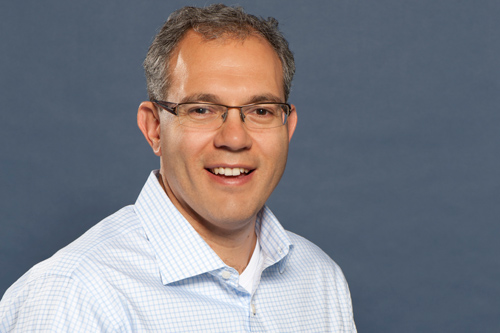
Dr. Andrew Morris, Director of the Antimicrobial Stewardship Program, UHN and Mt. Sinai, Project Lead for the ARTIC Antimicrobial Stewardship Program in ICUs. (Photo Credit: Andrew Morris)
Two projects led by University Health Network are helping to prevent the spread of potentially deadly hospital-acquired infections. They are doing so by decreasing the unnecessary use of antibiotics, and helping hand hygiene auditors monitor, understand and report hand hygiene results more accurately and objectively.
The research projects' rapid transformation into best practices across Ontario and even beyond Canada were recently hailed as success stories of high-impact change and collaboration by the Honourable Deb Matthews, Minister of Health and Long-Term Care, and the Council of Academic Hospitals of Ontario (CAHO).
It is CAHO's goal to transform bench-to-bedside research from one hospital to as many as possible, to benefit the health care system as a whole. CAHO has funded six projects through the Adopting Research to Improve Care (ARTIC) Program that have demonstrated innovation and improved quality of care.
CAHO is the non-profit association of Ontario's 24 academic hospitals and their research institutes.
'Champions of change'
"You are the leaders, the drivers, the champions of change," said Health Minister Matthews to the gathering of CAHO clinicians. "I have the deepest admiration for all of you."
About half of a hospital's antimicrobial budget is spent in the Intensive Care Units (ICU), and about 70 per cent of ICU patients are on antibiotics, yet ICUs do not have adequate measurements of their antibiotic use, said Dr. Andrew Morris, Director of the Mount Sinai Hospital-UHN Antimicrobial Stewardship Program (ASP) and the Project Lead for the ARTIC Antimicrobial Stewardship Program in ICUs. This project was the first in the world to develop a province-wide framework for measuring patient-specific antibiotic use in ICUs. Additionally, the project helped hospitals create a multidisciplinary team to carefully assess every day whether each patient in an ICU is receiving antibiotics appropriately.
"An Antimicrobial Stewardship physician lead, pharmacist and the ICU team meet at the patient's bedside to review and discuss if any antibiotics can be reduced or stopped altogether, with the emphasis on learning how to use antibiotics wisely and differently," said Dr. Morris.
On-line education tools were developed, and mentors from our own program were paired with "newbies" to reinforce the lessons learned.
Multidisciplinary collaboration is key
The project, modelled on work that the MSH-UHN ASP had already performed in our own ICUs, found that multidisciplinary collaboration with the ICU team results in improved patient care by reducing antibiotic-resistant bacterial infections, unnecessary antibiotic use and costs.
On average, 11 different ICUs in academic hospitals throughout the province achieved savings of $4,000 a month by establishing antimicrobial stewardship programs. The MSH-UHN ASP model is now the
de facto standard of practice for antimicrobial stewardship in Ontario.
An electronic tool developed by the Toronto Rehabilitation Institute (TRI) helps hand hygiene auditors monitor, record and report hand hygiene data objectively, accurately and consistently. Currently, paper-based observation systems are cumbersome, slow and prone to human error, reducing the effectiveness of the data.
Touch screen technology
Instead of recording and interpreting actions of health care workers on paper, auditors use touch screen technology to input different pre-programmed actions of every health care worker to create a step-by-step sequence of hand hygiene actions. Data is automatically analyzed and reports can be easily generated by health care category, site and unit right down to the individual level.

Michael Tsang, PhD, one of the developers of HandyAudit, an electronic tool to record and report hand hygiene data objectively, accurately and consistently. (Photo Credit: Michael Tsang)
"This is a powerful educational tool that helps health care institutions obtain more nuanced and accurate data, and use it objectively to target and learn about what specific steps need to improve in hand hygiene," said Michael Tsang, who created the tool while a Ph.D. student at TRI, with Dr. Geoff Fernie, Director, Rehabilitation Research, TRI and TRI scientist Dr. César Márquez-Chin.
Being part of ARTIC allowed the project to incubate in 16 academic research hospitals, and to demonstrate how it can help reduce the number of hospital-acquired infections by developing technologies that produce higher quality hand hygiene data.
A process survey of 16 academic hospitals found that using HandyAudit reduced time spent on auditing, mainly transcribing and report generation, by an average of 64 per cent. Additionally, a further case study shows that Hȏpital Montfort developed a comprehensive infection control program, which included HandyAudit, and found a 50 per cent reduction in infection rates in one year, and about $240,000 in savings.
More than 170 hospital sites in Canada and abroad are using HandyAudit, including Johns Hopkins and Denver Health, said Tsang, who is now Managing Director of HandyMetrics, a medical software services and technology company affiliated with TRI that is helping to advance sales of the electronic tool.
